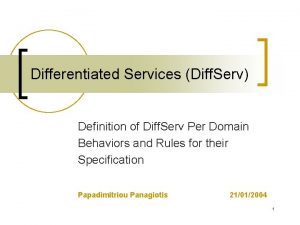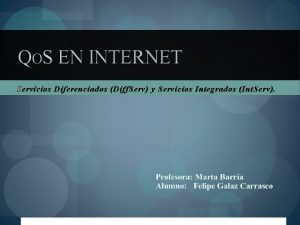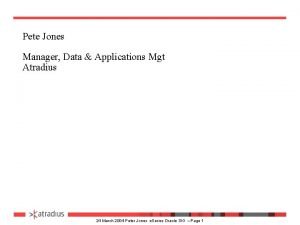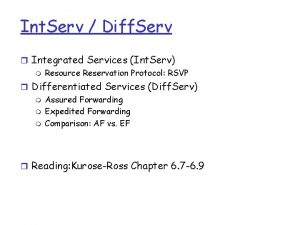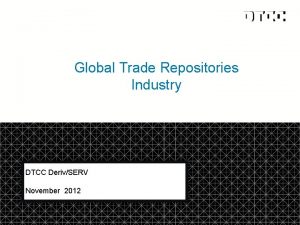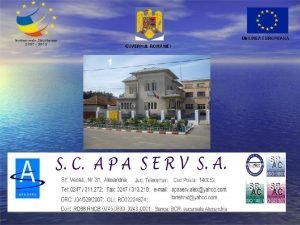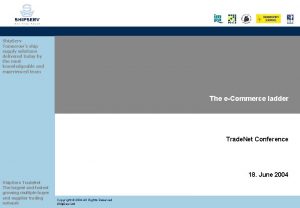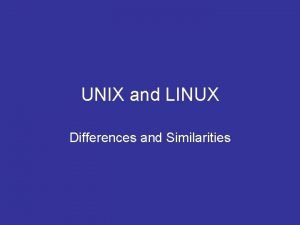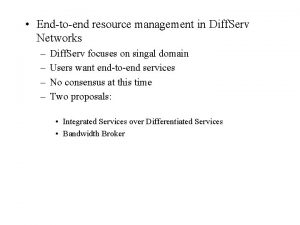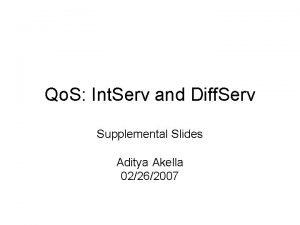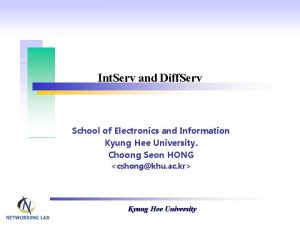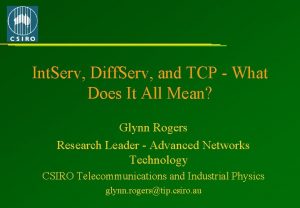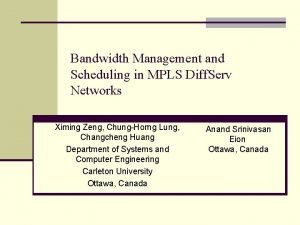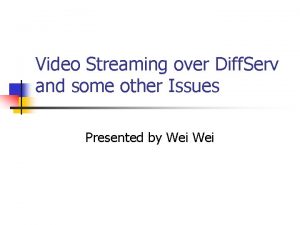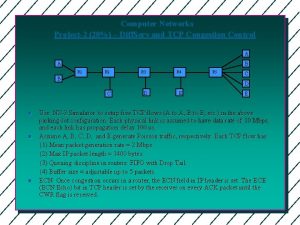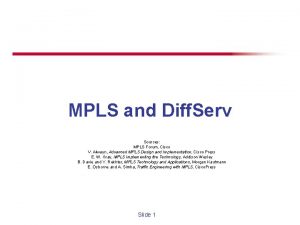Diff Serv and Qo S Support in Microsoft















- Slides: 15

Diff Serv and Qo. S Support in Microsoft Hosts Peter S. Ford peterf@microsoft. com NANOG, 8 June 1998

Agenda n n n Why Qo. S? Role of Hosts in providing Qo. S Microsoft NT Qo. S Components NANOG, 8 June 1998 Slide 2

Diff Serv WG Observation n “ 100 s of Bald Men arguing over 8 Combs” - An Internet Wag NANOG, 8 June 1998 Slide 3

What Needs Qo. S? n VPNs over the Internet u High value traffic - branch offices and telecommuters u Easy to do with static config of filter lists u Current focus of Industry Buzz n Applications sensitive to packet loss u SAP, SQL, RPC, SNA, DEC LAT, … u Web “RPC” - HTTP get u Audio over RTP/UDP - Voice over IP u Many of these are harder to do with static configurations based on layer 3 filters NANOG, 8 June 1998 Slide 4

Hosts and Qo. S n Qo. S, Diff Serv, etc. enhance carriage of application bits over the network n In many cases only the hosts/apps have knowledge of Qo. S needs u Certain web pages have priority Ø ports are not enough to classify traffic u End to end IP security Ø there are no ports to look at n Hosts have an important role in the evolving Qo. S landscape NANOG, 8 June 1998 Slide 5

Managing Resource Allocation In The Network n Current IP networks are “Best Effort” (BE) Standby Model w/in-flight bumping n “Qo. S Enabled Networks” - Network Resources allocated btw BE and “more important” traffic (e. g. queue, priority, bandwidth, etc. ) n Hosts signal network and request resource for entitled users/applications subject to Network Admission Control n Net Admins Authorize and Prioritize access to resources based on user application NANOG, 8 June 1998 Slide 6

Qo. S Mechanisms Exploited n Precedence/Priority u IP TOS/Precedence bits (layer 3) Ø tracking where differentiated services ends up. . . u IEEE 802. 1 p (layer 2) n Application Flows can be isolated, prioritized and scheduled by the Stack n Signaling into Network (RSVP, ATM) n Network Admins configure Qo. S Policy on hosts and in the network NANOG, 8 June 1998 Slide 7

Microsoft Qo. S Components LDAP for Policies Qo. S-aware Network mgmt. application Qo. S SP TCI API TCP/IP Packet Scheduler ACS/SBM Netcards Packet classifier Directory Services for Win. Sock 2 Qo. S Policy API Storage Routers/Switches NANOG, 8 June 1998 Slide 8

DS based Qo. S Networking Receiver FTP Netmeeting RSVP Traffic control 802. 1 p Priority Prio=5 RSVP PATH 1 Mbps controlled load \redmonduserx DS ISP w/Diff Serv Check \redmonduserx ACS Router Packets Rescheduled Prio=1 NANOG, 8 June 1998 Slide 9

Microsoft Qo. S Components n Win. Sock 2 Generic Qo. S API u Allows applications to request the Qo. S they need, regardless of the underlying mechanisms (RSVP, IP Priority, . . . ) n Qo. S Signaling - End System to Network u Explicit - RSVP with Policy Objects (e. g. user id) Ø integrated with IPSEC u Implicit - IP Diff Serv /IEEE 802. 1 p n Traffic Control API w/Kernel Stack Support u Kernel based queueing of traffic flows u IP, IEEE 802. 1 P precedence/priority n Admission Control Service u u u Qo. S Directory Console for Network Admins In network policy enforcement Also adds L 2 shared media management NANOG, 8 June 1998 Slide 10

ACS Management Model n Network Administers Qo. S Policies in the Directory Service u User Object is extended to permit a mapping from a User to a Group Profile Ø e. g. RedmondBob -> Programmers u Default policies at Organization Level Ø “All users can reserve up to 500 Kbps” Ø “Programmers get 100 Kbps” Ø Enterprise-wide User, Profile policies u Per Subnetwork Policies Ø Individual Users and Group Profiles NANOG, 8 June 1998 Slide 11

ACS Policy Operation n Host RSVP service provider inserts RSVP policy objects in RSVP messages u Contains User Identity represented as an encrypted DN {dc=com, dc=microsoft, ou=redmond, n=bob}Ksession u Security token to prove identity (kerberos ticket for ACS service) Ø Ticket encrypted in private key of ACS service Ø Session Key (Ksession) is in Ticket u Digital signature over RSVP message to avoid policy object reuse (cut and paste) n ACS servers in network authorize requests u Crack ticket to get identity of requestor u Check User’s Policy in the Directory NANOG, 8 June 1998 Slide 12

In Summary n Need many pieces of Qo. S picture to satisfy customer requirements u Diff Serv for ISPs and large networks u Fine grain policy control u Centralized management for Qo. S Policies Ø both Diff Serv and RSVP signaled flows Ø Use of Directory services n RSVP may prove useful in many ways u Internal provisioning of Qo. S - PASTE (Li and Rehkter) u Customer to ISP - dynamic signaling instead of the desert of pre- provisioning NANOG, 8 June 1998 Slide 13

Admission Control Services Policy Functionality n Admission Control Servers u part of RSVP process on a network server (NT, switch, router, etc. ) u implements RSVP and SBM u ACS takes requests and tests against policy and/or resource limits n Hosts can use RSVP signaling u Hosts on LANs also participate in SBM n Policies are maintained in the Directory (DS) u u ACS uses LDAP to retrieve Policy Information from DS ACS Policy is per subnetwork/per user Can be abstracted to “per Enterprise/Per Group” Enables approval/denial of resources based on user ID, time of day, resource limits (bandwidth, priority, . . . ), etc. n Can Aggregate requests into priority groups at ISP/WAN interfaces u can “re-write” user id to corp id at ISP boundaries NANOG, 8 June 1998 Slide 14

Extensibility of ACS Policy Framework n Can add new policy objects to RSVP messages n Can add new policy interpretation modules to ACS servers u API to call out to policy module n Can extend ACS policy objects in the Directory n End Systems can pull policy down from Directory to configure Qo. S NANOG, 8 June 1998 Slide 15
 Serv definition
Serv definition Diff serv
Diff serv Diff in diff regression
Diff in diff regression 3 errors that affect the trial balance
3 errors that affect the trial balance Trading profit and loss account format
Trading profit and loss account format Atradius serv net
Atradius serv net Int serv
Int serv Global trade repository
Global trade repository Rekeszizom erősítése
Rekeszizom erősítése Apa serv alexandria
Apa serv alexandria Brutus remote password cracker
Brutus remote password cracker Ship serv
Ship serv Differnce between unix and linux
Differnce between unix and linux Datagram network diagram
Datagram network diagram Optical fibre
Optical fibre Non primitive data structure
Non primitive data structure
